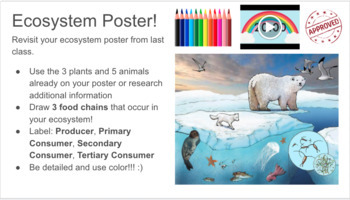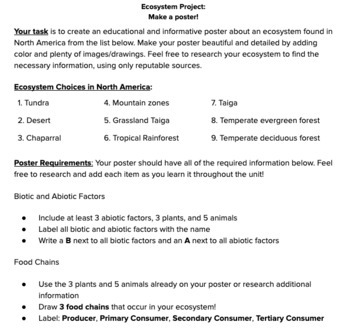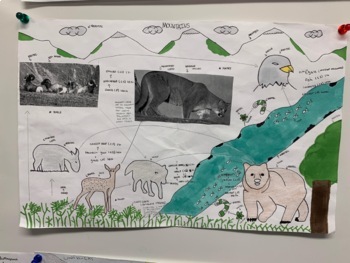Ecosystems/Ecology Poster Project
- Google Drive™ folder

What educators are saying
Description
This product guides students through the creation of a poster of an ecosystem that illustrates all of the key concepts learned in a unit on ecology. Students begin by drawing abiotic and biotic factors (plants and animals) of an assigned/chosen ecosystem and then add various symbols and labels as they go to illustrate concepts such as food webs, trophic levels, transfer of energy, limiting factors, keystone species, and more. This project assesses student understanding of how ecosystems function beyond what can be tested on an exam, as students must apply what they have learned in class to an ecosystem that they are unfamiliar with. The project also requires them to conduct internet research, improving their source evaluation and evidence collection skills. For best results and maximum creativity, encourage students to use bigger sheets of paper or larger slides/Google Drawing sizes! This project is engaging for students of all levels and varying interests. Many of my students were extremely dedicated to drawing detailed animals while others enjoyed printing clip art off the internet, gluing it on to their poster, and coloring it in.
This project would be suitable for in-class learners as well as distance learning and hybrid models. Students from middle school through high school will find this project accessible, engaging, and appropriately challenging. We began this poster project at the beginning of our Ecology Unit and had students add on to their poster after each new concept that we learned, culminating in a beautiful poster at the end of the unit summarizing all of the student’s learning. We here at EnvironmentLA used this as the basis for a project-based learning (PBL) unit on ecosystems and ecology in our high school Environmental Science classes, but this project would also be great for Biology, Integrated Science, or middle school science classes. All materials included with your purchase are hosted on Google Drive, making it easy and ready-to-teach for you to post immediately for your students!
Documents included in your purchase:
- Ecosystem Poster Project Brief
- Ecosystem Poster Requirements - Teacher Slides (Google Slides)
To extend this project, check out our Ecosystem Project: Nature Documentary where students can turn their poster into a movie complete with video clips of their ecosystem and voice over narration describing the ecology concepts found in their ecosystem. You can find the Ecosystem Project: Nature Documentary here, or buy both projects as part of our Ecosystem Project Bundle.





